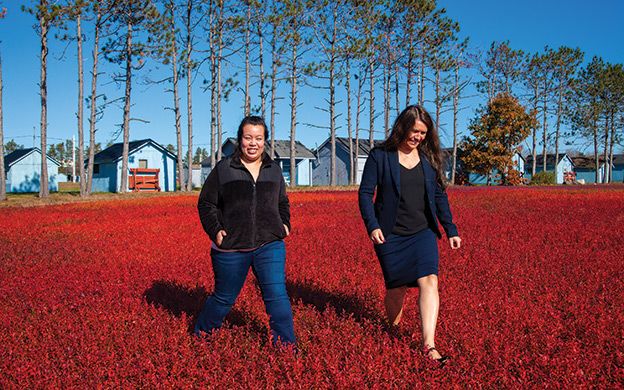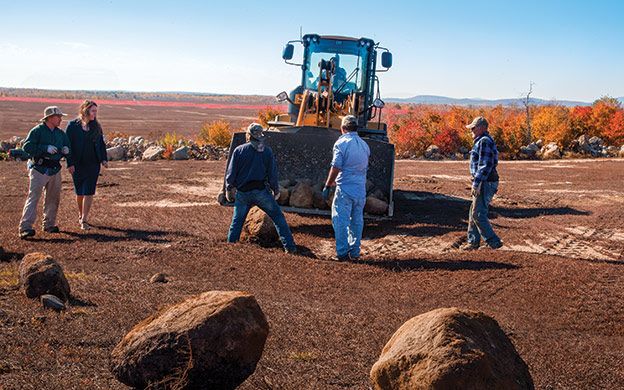As Maine's labor supply shrinks, its reliance on migrant workers grows
Every May, Wyman's of Maine, the wild blueberry grower, sends out correspondence to its migrant workforce, reminding them that the wild blueberry harvest season is coming up, and including contact information so the migrants can stay in touch.
Wyman's employs about a fifth of the seasonal migrant workers hired for Maine's wild blueberry harvest. Every year, migrant workers in Maine — whether they are hired for the wild blueberry harvest or to pick apples or broccoli or make wreaths — come from a variety of places and get around in a variety of ways. The Maine Department of Labor calls agricultural workers something of an unseen workforce, not particularly visible to the average Mainer. Their travels are something of a hidden saga.
For employers, seasonal workers are a boon, says Nancy McBrady, executive director of the Wild Blueberry Commission of Maine, which supports an industry evolving with mechanization, resulting in a decline in worker numbers for raking. But seasonal workers today have new responsibilities — operating heavy equipment, integrated crop and pest management and other tasks. First and foremost, she says, employers rely on these farmworkers.
“We don't have sufficient labor supply locally to fill those jobs,” she says. “So employers rely on seasonal workers. They're very much a part of making the harvest happen.”
Florida to Maine and back again
Wyman's director of human resources, April Norton, shared insights about the travels of that company's migrant workforce.
Many of the migrants who work at Wyman's, which produces approximately 40 million pounds annually, are part of the so-called Eastern Migrant Stream. There are three primary migrant streams in the United States — Eastern, Midwestern and Western. For the Eastern Stream, in general, people follow the Atlantic seaboard, working on farms to pick and process different fruits, vegetables and tobacco. From late October to mid-May, according to data published by the Florida Association of Community Health Centers, many folks are in Florida, picking citrus and many other fruits and vegetables. Some might be in North Carolina, Tennessee, Kentucky or Virginia, picking tobacco. A primary destination, once those crops are harvested, is New Jersey, where high-bush blueberries, among other crops, will be ready to harvest in July.
Wyman's employs both a full-time and part-time staff, says Norton. This year, 16%, or 28 people, of the full-time staff originally came from the migrant pool but have settled in the area. Of the 488 seasonal migrant workers, 43% are from Mexico, 25% are United States residents, 16% are from Puerto Rico, 6% are from Haiti, 9% are from Honduras and 1% are from Canada.
It's the seasonal workers who follow that general Eastern Stream. About 90% of Wyman's workforce are returnees, says Norton. It appears, anecdotally, that most of the seasonal group is in Florida for that October-to-May period, then typically migrate to North Carolina to harvest cultivated blueberries, then to New Jersey, for more cultivated blueberries. In the case of the Haitian workers, they tend to go from Florida to northern Maine to pick broccoli. In any case, all of the workers — traveling in groups usually defined by nationality, family or friends or on their own — are by that time in constant touch with Wyman's.
“They all know the season is coming up, and they or their families call us to find out when we'll start, because it's a fine line between when cultivated ends and wild starts,” says Norton.
When the various groups hear the wild berries are ready, they head to Wyman's farm office in Deblois, where the barrens and housing are located. Deblois is about 25 minutes from Wyman's headquarters in Milbridge; both are in Washington County.
Wyman's harvest and processing season typically starts late July and runs through the first couple of weeks of September. At the farm office, those first few days of en masse arrival look like this: “It's a lot of people,” says Norton. “They arrive in different ways. We have buses that show up. We have cars or vans that show up with large groups of people and usually no spare room in any of them. We have some who come into the Bangor airport, and we pick them up. Our Puerto Rican group doesn't usually travel in personal transportation; it's usually public transportation.”
As folks arrive, Wyman's year-round staff gets everyone situated with their housing, either in cabins, reserved for families and women, or dormitories, with separate kitchen cabins. Even though most are returnees — some families have been with Wyman's for over 30 years — there's still a couple of days of paperwork and orientation to be done, all handled by Norton, her assistant and their staff of eight.
The end of the season is always a bit iffy, being weather-dependent.
“Once we get to Labor Day, that's the crucial point,” says Norton. “We want to have most of our work completed before that. These are mostly families, and they have children who need to be in school. We do have a migrant school set up in town, where the kids are bused every day through harvest. But the kids need to be enrolled, at the start of school year, where their families are planning to be.”
Those plans vary. Many migrants leave for other farms in Maine to harvest early-fall crops, mainly pumpkins, potatoes or apples. Then, once Pennsylvania and New York open for apples, most workers head there. When the apple season finishes, they usually go straight back to Florida to start the circuit again. A small number head to California to pick grapes and some go to Texas. Some families stay in Maine, picking apples and then making wreaths. So some of the children attend school in the local district until the end of the wreath season, then families usually return to Florida, or perhaps to Texas, and will enroll their children in school there.
Companies mix HR skills with logistics
Migrant workers are people who travel to find seasonal work and are unable to return to a permanent home at the end of the workday. Some are born in other countries and some in the United States. Other people who work on Maine farms include Mainers and tribal members, who might leave home for a brief period but have year-round jobs in their hometowns.
According to the Maine Department of Labor, a 2012 U.S. Department of Agriculture National Agricultural Statistics Service census says 125 Maine farms reported hiring 2,706 migrant workers; that's about 18% of Maine's hired farm labor workforce.
Jorge Acero, the Bureau of Employment Services' State Monitor Advocate for Migrant and Seasonal Farmworkers, outlines a route similar to that described by Norton.
There's another group of traveling agricultural workers: That's guest workers —folks who arrive from other countries to work for a specific employer on the U.S. Citizenship and Immigration Services' H-2A temporary agricultural worker visas. In 2015, 28 Maine agricultural employers filed for 635 job openings (not all openings are always filled). Under this strictly regulated program, employers must first advertise job openings, then can apply for guest workers if they're unable to fill the openings. Employers pay for transportation and housing costs.
“Someone meets them at the border, say it's Texas, if they're coming from Mexico or, if they're coming from Jamaica, they might fly into Miami or Atlanta,” says Acero. “Once they pass customs, they take a bus up to Maine and the employer meets them at the bus station in Portland or Bangor with vans and transport them to the farm. The employer provides good housing free of charge” and meals either at a per-day rate set by the U.S. Department of Labor, or access to a fully equipped kitchen. Employees receive a first-week's-wage guarantee, in case there's a delay in the start date. And employers must provide transportation from living quarters to worksite. Most have vans; larger operations have buses.
Most guest workers in Maine are from Mexico and Jamaica, says Acero. Why there?
“Historically, at the inception of the program, there were people involved who had already been sourcing workers in Jamaica,” he says. “So there is a bond, at least in the Northeast. On some Maine farms, Jamaican workers have been coming for 20 years. It's the same thing for Mexico, except it's usually by word of mouth —'I have a cousin in my hometown. Can we bring him in?'”
Another big traveling cohort comes through the H2-B temporary non-agricultural worker program, bringing people from all over the world to work mainly in hospitality, but also other industries such as seafood processing and light forestry. In 2015, 123 employers filed for 2,507 openings.
The two temporary worker programs are essential for Maine, says Acero.
“Farms say they can't find local people who will stay on through the season,” he says. “Sometimes they start at the beginning of the season, but they don't go back. And in the hospitality industry, they say they just can't find enough people to fill their need. There are so many restaurants and hotels from Kittery to Bar Harbor that it's pretty difficult.”
Air travel is cheaper than hiring new workers
Smith's Farm in Presque Isle employs both migrant and guest workers. A large grower of broccoli and other produce, Smith's has several operations outside of Maine, so air transportation is involved. The company flies about 100 migrant workers at a time from California to Boston in July for the broccoli harvest. In Boston, the group boards five charter buses that take them directly to the farm. The group flies back to California in October, then Florida in November, back to California in the middle of April, then California again at the end of April or the first of May. The company pays all transportation and associated costs.
Company President Emily Smith, a member of the 2016 Mainebiz Next Class, has big props for the travel companies that assist, especially Cyr Bus Line in Old Town and Crown Travel in Presque Isle. Logistical challenges include syncing up travel times with the harvest, especially during busy tourist seasons.
“We've learned what works and what doesn't and how to streamline the process,” says Smith.
Many migrants have worked at Smith's Farm 20 to 30 years. “We have some well-traveled crew members who have made the trip many times,” says Smith.
Smith also began using the H2-A program two years ago to employ people from Mexico. The company now has many returnees.
“We have such a large base of people from California who have family in Mexico, it made sense to bring in family members,” Smith says.
That transportation process takes time. Employees go to the U.S. consulate for a visa, which takes two to three days to clear. The company pays for the interview and visa, and for the employee's time, transportation costs from hometown to consulate, and hotel costs in the consulate city. The company charters buses from the consulate city to Maine, with food and hotel costs paid. Charter bus companies, mainly in Texas, work with farms to see if trips can be batched together, which sometimes helps mitigate expenses, says Smith.
Read more
High supply and weak Canadian dollar worry Maine blueberry growers
#MBNext16: Emily Smith proudly expands a sixth generational Aroostook legacy












Comments